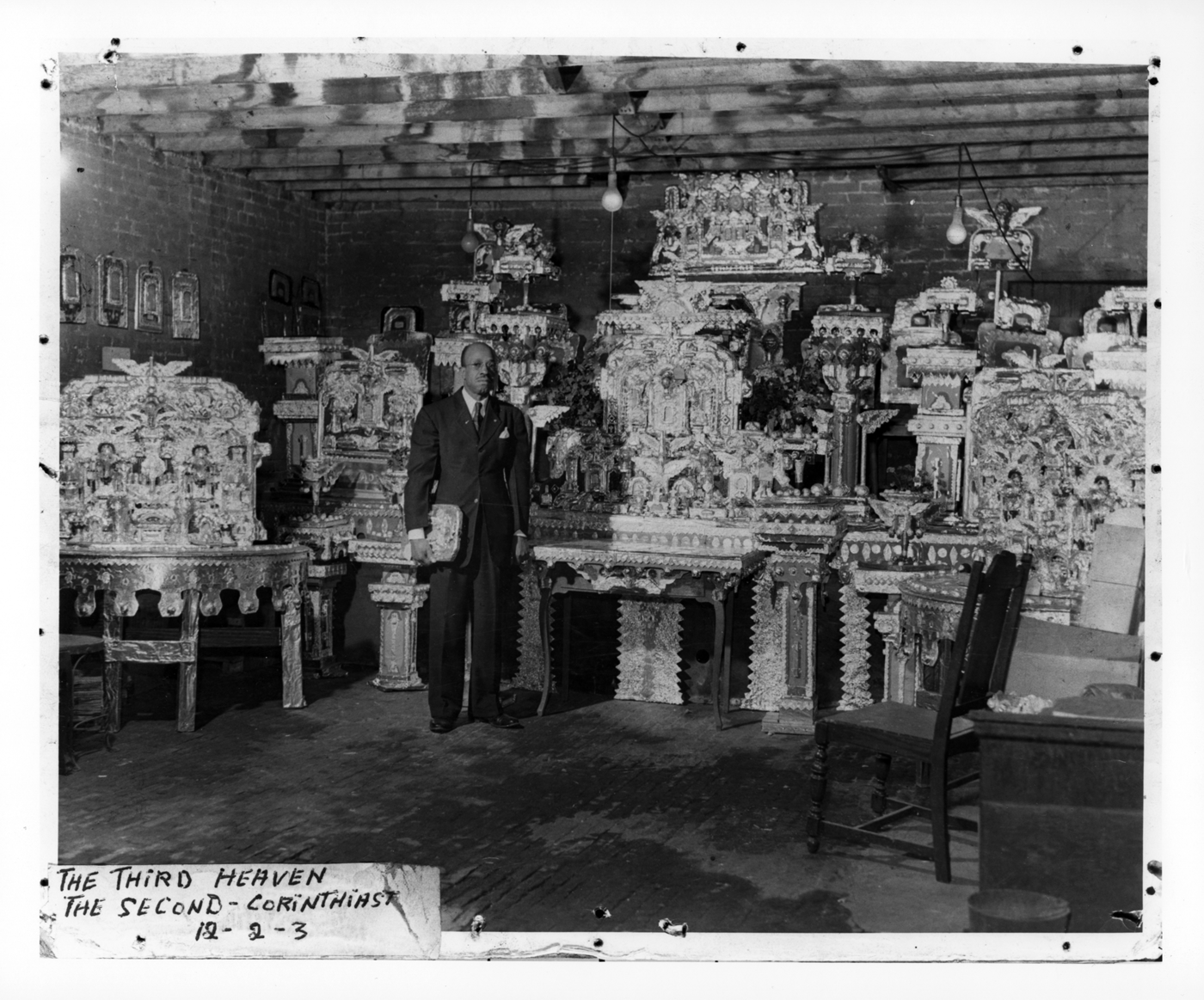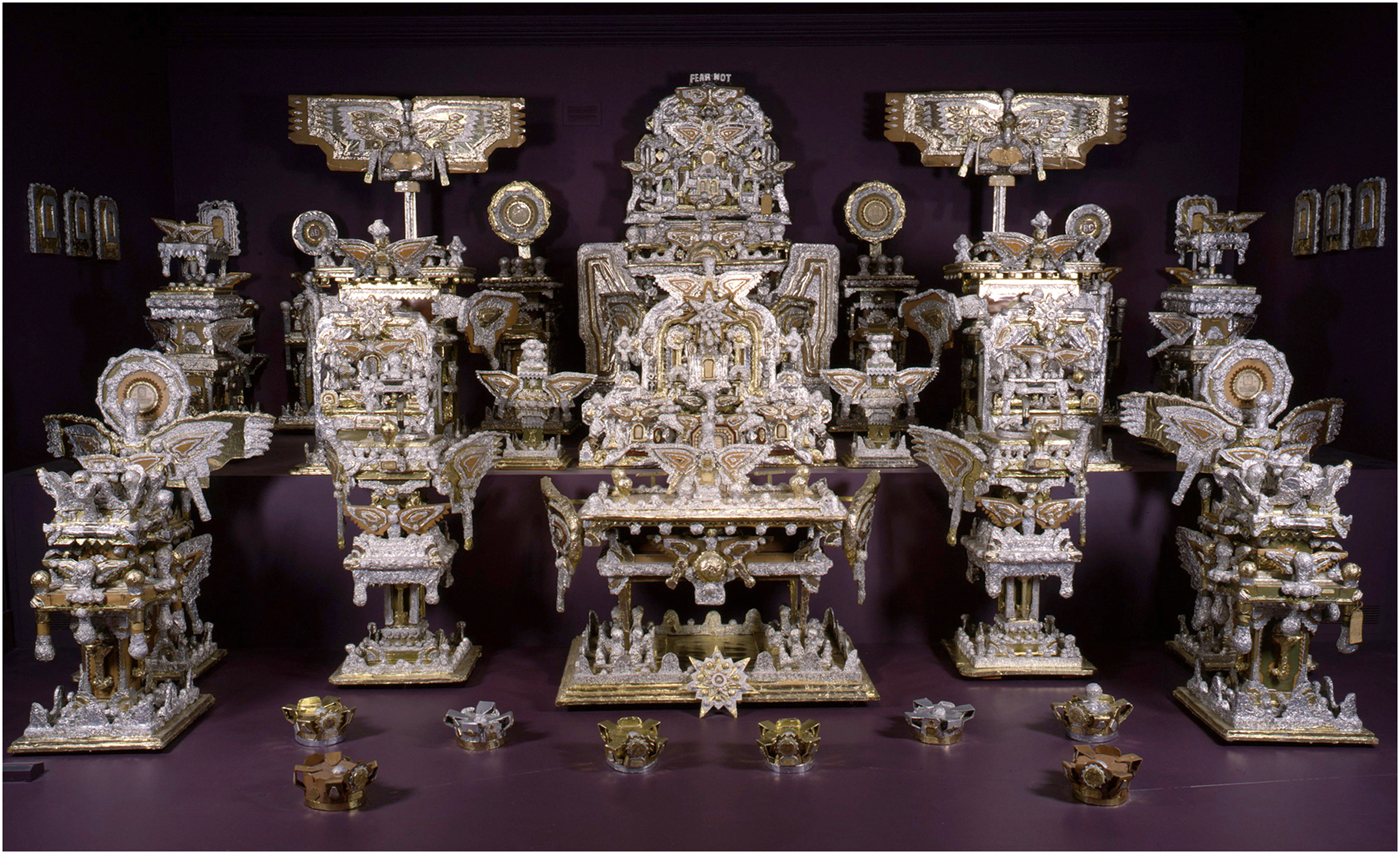

The artist James Hampton, celebrated today for his sculptural masterpiece The Throne of the Third Heaven of the Nations’ Millennium General Assembly, would never have imagined that his devotional creation might one day alter the course of American art. When Hampton's resplendent, pulpit-style array was discovered, soon after his death in 1964, the nature and meaning of his complex project – fashioned from discarded oddments, wood, cardboard and metallic paper and foil – was little understood. It was interpreted foremost as a work of Christian visionary art, but presumptions regarding the sanity of a man who had spent his free time alone, consumed with bringing his grand vision to fruition, cast Hampton as eccentric, if not mentally unsound. Over time, as scholars increasingly situated his endeavour against the backdrop of African American history and culture, The Throne became grasped as a historically and culturally rooted work of art rather than an isolated oddity, paving the way for an expanded understanding of American artFootnote 1 (Foy and McMurrer, Reference Foy and McMurrer1975; Cep, Reference Cep2017).
Hampton was born in 1909 in an impoverished South Carolina community largely made up of black sharecroppers and tenant farmers. His father, a Baptist minister, abandoned the family to pursue his itinerant calling (Quigley, Reference Quigley1971; Hartigan, Reference Hartigan1974, Reference Hartigan1976, Reference Hartigan1977). At nineteen, Hampton followed the ‘Great Migration’, north to Washington, DC. He served in a segregated, noncombatant unit during the Second World War, and returned to Washington in 1945, working thereafter as a janitor in a federal building.
The grand nationalistic memorials and statuary (overwhelmingly dedicated to deceased white men) that lend the US capital city much of its character may have inspired Hampton to create his own kind of monument (Hartigan, Reference Hartigan1977). Hampton's coming-of-age in the 1920s dovetailed with a simmering unrest in the African American community – turbulence that would steadily swell into the American civil rights movement, as he doggedly worked into the wee hours, after his night shift had ended. Hampton wrote that his first spiritual vision came to him in 1931, but it was in 1950 that he rented an unheated carriage house to more fully accommodate his creative undertaking – a setting befitting the second coming of Christ. Hampton crowned the central chair element with the words ‘Fear Not’, and a note on his bulletin board kept another driving motto close at hand: ‘Where There Is No Vision The People Perish’.
Hampton organised his array symmetrically, dividing it into mirrored halves honouring Old and New Testaments of the Bible. Texts are a key part of The Throne, much of it written in an asemic script, possibly a visual counterpart to speaking in tongues or an idiolect conveying the word of God as he received it. Hampton, who referred to himself as ‘St. James’, repeatedly mentions the book of Revelation and the Kingdom of God on earth.
Hampton died at age fifty-five, without finishing his project. When it was found, the DC art community took notice. The Throne was acquired by the Smithsonian American Art Museum (SAAM) in 1970 and went on view soon after. By the 1980s, Hampton's shining oeuvre was widely lauded, but situating it within the larger framework of American art history remained challenging. It was variously called ‘visionary’, ‘black folk art’ and ‘outsider’ art. ‘Visionary’ captured part of the object's true nature – having been inspired by spiritual prompts. ‘Folk art’ historically referenced works emanating from communal traditions or trades. Yet when applied to Hampton and other impoverished black artists, ‘folk’ alluded, instead, to the maker's disenfranchised social status, and utterly missed the mark in describing the art. ‘Outsider’ was coined in 1972, in an effort to translate the European art brut, or raw art – often made by artists of varying mental faculties, or who were isolated from their larger culture in significant ways (Cardinal, Reference Cardinal1972). But in the United States, ‘outsider’ became a euphemism for race and class; a catchall term signalling marginalised artists, but one that never meaningfully positioned or illuminated the art itself. In the case of black artists – enslaved, persecuted and degraded from their first moments in America – marginalisation has almost always gone well beyond issues of professional v. nonprofessional or rural v. urban; tapping into deeply fraught issues of power and humanity.
By his own description, Hampton's art was rooted in a Christian vision. The manifestation of that vision, however, reflects a larger continuum, ‘a stylistic reshaping of age-old ‘yard shows’, also called dressed yards or spirit yards, describing manners of embellishing homes, graves, and other personal places that trace from Africa throughout Caribbean, into the American South, and beyond’ (Umberger, Reference Umberger2018). As African Americans increasingly had personal spaces they could freely alter, such embellished or fabricated spaces became bolder, more visible. In 1983 the Harvard art historian Robert Farris Thompson published his groundbreaking book Flash of the Spirit: African and Afro-American Art and Philosophy, persuasively arguing that projects like Hampton's comingled African spiritual traditions and survivalist strategies in America. Thompson assessed The Throne as more than a Christian devotional array, revealing it as a multivalent fusion of African folk religion and black formations of Christianity in America, and the embodiment of protective spiritual practices and pathways to ancestral memory – critical tools in a land that had, for centuries, sought to suppress and terminate cultural roots, pride and identity (Thompson, Reference Thompson1983).
In 1970, on view to a national audience and garnering the attention of DC's local African American community in a way that artworks at SAAM previously had not, Hampton's oeuvre revealed the acute need for museums and scholars to delve into a richer, fuller and more honest assessment of American art and its creators, who comprised a diverse and complicated national identity. It was the dawn of an institutional awakening to serious fault lines in an über-narrative that had long ignored unflattering historical truths and enabled the presumption of the inferiority of non-European cultures.
The Throne's installation at SAAM was timely. Hampton had been working on his project throughout the 1950s, as Martin Luther King Jr. became the leader of the American civil rights movement. He lived to see the historic March on Washington and King's ‘I Have a Dream’ speech on the National Mall in August of 1963. Hampton did not, however, live to see the fateful the day on which King was assassinated, and the subsequent riots that destroyed much of the neighbourhood in which Hampton had fabricated The Throne. His masterpiece became an enduring icon at SAAM, and this heartfelt object, which is both astonishingly splendid and profoundly humble, still elicits overwhelming visitor response. Study of Hampton's work in relation to African divination systems and syncretised religious practices continues today. At SAAM, Hampton is positioned not as a marginalised maker, but as one of America's most important artists; his life's work is celebrated as an elaborate, uniquely African American project embodying deep cultural roots and autonomous, creative testimony.
About the Author
Since the late 1990s, curator and art historian Leslie Umberger has focused on artists who navigated autonomous artistic paths, often in the face of oppression or personal challenge. Umberger has served as Curator of Folk and Self-Taught Art at the Smithsonian American Art Museum (SAAM), in Washington, DC, since 2012, where recent projects include the 2018–19 retrospective exhibition: Between Worlds: The Art of Bill Traylor, and the 2017 reinstallation of SAAM's galleries for folk and self-taught art. Between Worlds was accompanied by a monograph of the same title co-published by SAAM and Princeton University Press (2018). Other notable publications include: Something to Take My Place: The Art of Lonnie Holley (2015); Untitled: The Art of James Castle (2014), and Sublime Spaces & Visionary Worlds: Built Environments of Vernacular Artists (2007).
Carole Tansella, Section editor


